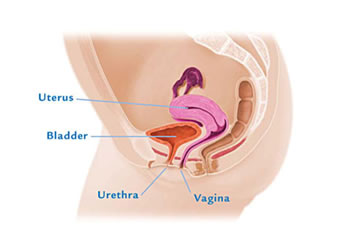|
Women's Health
Women's Health Physiotherapy deals with problems specific to women, due to our particular anatomy and physiology throughout the different stages of life. This is a relatively new field of physiotherapy, with few specialised practitioners in South Africa. This website will help you understand the pelvic floor, common conditions treated in physiotherapy, and advise you on options of treatment. Understanding the Pelvic Floor  What is pelvic floor? The pelvis is a bowl containing the bladder, uterus and the bowel. The sides of the bowl are made of bone and the floor of the bowl is made of muscle. This important muscle floor is made up of layers which stretch from the front to the back of the bowl. The muscle floor is commonly known as the pelvic floor. There are openings in the pelvic floor for the urethra (pipe from the bladder), the vagina (birth canal) and the rectum (back passage). The pelvic floor muscles support these internal organs, play an important role in urination and defaecation and sexual function. Why must we keep the pelvic floor strong? The pelvic floor plays an important role in maintaining urinary and faecal continence by helping keep the outlets from the urethra and the rectum closed until it is convenient to get to a toilet. A weak pelvic floor may not provide sufficient support for this process, resulting in leaking of urine on coughing, sneezing, laughing, straining or playing sport. This is known as Stress Incontinence. In some cases, there could also be leakage of faeces, and/or an inability to control the passing of gas from the rectum. Urge incontinence is the loss of urine with an urgent need to pass urine and may also be associated with a weak pelvic floor ("key in the lock", "don't make it to the toilet on time"). In addition, weakness may allow prolapse of the internal organs (aching, "falling out" feeling): a)The uterus may move downwards through the vagina (prolapse), or b)The bladder may bulge into the front wall of the vagina (cystocele), or c)The rectum may bulge into the back wall of the vagina (rectocele). Why do the pelvic floor muscles weaken? Pelvic floor muscles may be weakened by: a) Pregnancy and childbirth b) Continual straining to open the bowels (constipation) c) Persistent heavy lifting (e.g. nurses) d) High impact sporting activities e) A chronic cough (e.g. asthma, chronic bronchitis or smoker's cough) f) Obesity g) Inactivity/lack of general fitness h) Changes in hormone levels at menopause How can physiotherapy help? Physiotherapy is often the first step taken to help correct pelvic floor disorders. By means of a simple and painless vaginal examination a physiotherapist can establish the strength, endurance, quality and structure of the pelvic floor. After a thorough assessment a unique exercise and bladder training programme for each patient can be developed. The aim is to strengthen the pelvic floor in order to provide greater support for the bladder, bowel and vagina, thus reducing symptoms. Many women may avoid the need for surgery and in others where surgery is unavoidable, a strong pelvic floor will provide the best possible chance of success in the years following the surgery. If you think you suffer with any degree of stress or urge incontinence and/or you think you may be in the early stages of a prolapsed, cystocele, or rectocele it is important for you to discuss this with your doctor, midwife, or your local physiotherapist specializing in women's health. Your doctor may prescribe a simple exercise routine or will refer you to physiotherapy for a more detailed assessment and individual treatment plan or to a gynaecologist. For a simple explanation of how to do Pelvic Floor Exercises, click here. |